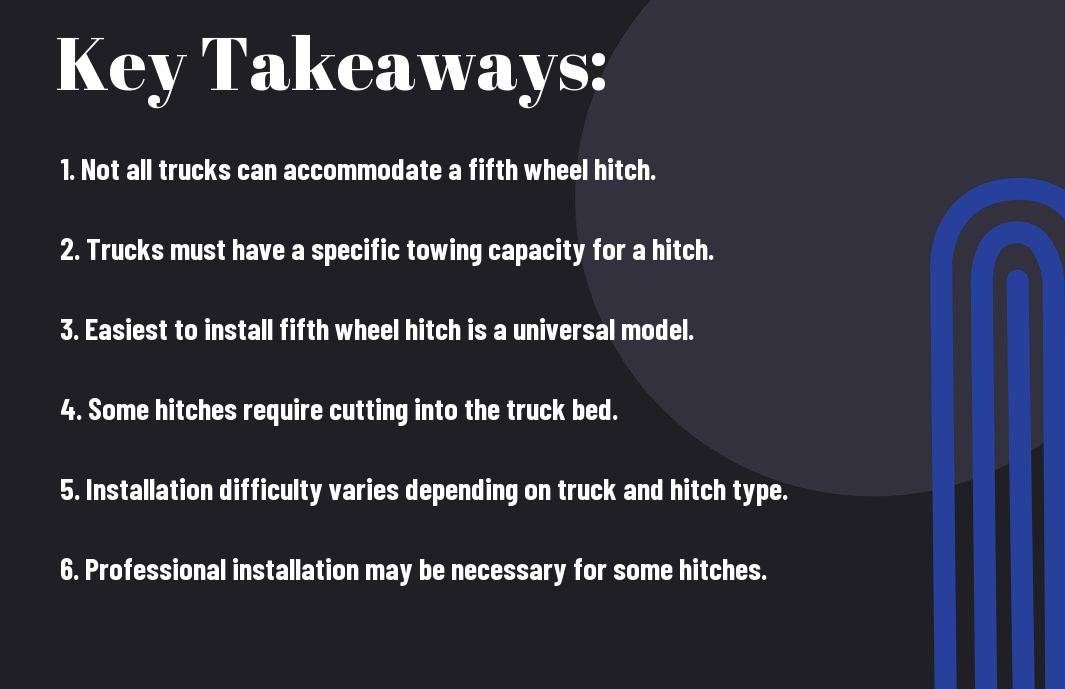You’ve just purchased a fifth wheel trailer, and now you’re wondering if you can put a fifth wheel hitch on your truck. The good news is that most trucks can be equipped with a fifth wheel hitch, but it’s essential to choose the right hitch for your specific make and model. The easiest fifth wheel hitch to install is the industry-leading B&W Companion, known for its user-friendly design and simple installation process. However, installing a fifth wheel hitch is not without its challenges. While it’s possible to do it yourself, some installation steps can be complex and require a certain level of expertise. Additionally, improper installation can pose serious safety hazards, so it’s crucial to follow all instructions carefully and consider consulting a professional if you’re unsure about any aspect of the process.
Key Takeaways:
- Not all trucks can accommodate a fifth wheel hitch: While many trucks can be fitted with a fifth wheel hitch, not all are capable of supporting the weight and structure of the hitch.
- Check your truck’s towing capacity: Before attempting to install a fifth wheel hitch, it is important to confirm that your truck has the necessary towing capacity to safely pull the fifth wheel trailer.
- Consider professional installation: While some fifth wheel hitches are designed for easier installation, it may still be best to have a professional install the hitch to ensure proper fit and safety.
- The easiest fifth wheel hitch to install: Some popular brands, such as B&W and Curt, are known for their user-friendly installation processes, making them easier for DIY enthusiasts.
- Installation difficulty varies: The difficulty of installing a fifth wheel hitch can vary depending on the specific hitch and the truck it will be installed on. Some require drilling or modification, while others are designed for straightforward installation.
- Consider weight distribution and stability: When installing a fifth wheel hitch, it’s important to ensure that the weight distribution and stability of the hitch and trailer are properly balanced for safe towing.
- Follow manufacturer guidelines: Whether installing the hitch yourself or having it professionally done, always follow the manufacturer’s guidelines and recommendations for installation and usage.

Compatibility of Trucks with Fifth Wheel Hitches
One of the most common questions when it comes to fifth wheel hitches is whether they can be installed on any truck. The answer is not straightforward, as it depends on the specific make and model of your truck. Not all trucks are suitable for fifth wheel hitches, and it is crucial to understand the compatibility factors before making a decision.
Factors Determining Hitch Compatibility
When considering the installation of a fifth wheel hitch on your truck, several factors come into play. The primary considerations include the weight rating, bed size, and towing capacity of your truck. It is essential to ensure that your truck’s towing capabilities align with the requirements of the fifth wheel hitch. Additionally, the bed size of your truck is crucial, as it will determine the installation process and whether modifications may be necessary. Lastly, the weight rating of your truck is a critical factor that must not be overlooked. Recognizing these factors will help you determine the compatibility of your truck with a fifth wheel hitch.
Examples of Suitable Trucks for Fifth Wheel Hitches
Trucks such as the Ford F-Series, Chevrolet Silverado, and Ram 1500 are prime examples of vehicles that are suitable for fifth wheel hitches. These trucks have sturdy frames, ample towing capacities, and the necessary bed size to accommodate the hitch installation. Additionally, they are popular choices among RV enthusiasts for their reliability and performance when towing heavy loads. If you own any of these trucks or a similar model, you can confidently explore the option of installing a fifth wheel hitch.
Selecting an Easy-to-Install Fifth Wheel Hitch
After deciding to install a fifth wheel hitch on your truck, the next step is to select the right hitch for your needs. You’ll want to find a hitch that is not only compatible with your truck but also easy to install. Here’s how to choose an easy-to-install fifth wheel hitch to make the process as smooth as possible.
Top Contenders for Easy Installation
When it comes to easy installation, some fifth wheel hitches stand out from the rest. Look for hitches that come with a simple, bolt-on installation process. These hitches typically require minimal drilling and can be installed with basic hand tools. Additionally, hitches with a single-piece base design are often easier to install than hitches with multiple components that need to be assembled.
Key Features to Look For
When selecting a fifth wheel hitch for easy installation, there are several key features to consider. Look for a hitch with wide kingpin jaws that make it easier to guide the trailer into place. Additionally, hitches with a sliding rail system can simplify the installation process by allowing for flexibility in positioning. You’ll also want a hitch with adjustable height settings to ensure a proper fit with your truck.
- Wide kingpin jaws for easier trailer maneuvering
- Sliding rail system for flexible positioning
- Adjustable height settings for proper truck fit
After considering these key features, you can select a fifth wheel hitch that is not only easy to install but also meets your specific towing needs.
Installation Process for a Fifth Wheel Hitch
To ensure a safe and successful installation of a fifth wheel hitch on your truck, it is important to follow the correct process. Below, we have outlined the necessary steps and tools required for installing a fifth wheel hitch.
Tools and Equipment Needed
Before you begin the installation process, you will need to gather a few essential tools and equipment. Having the right tools on hand will make the installation process much smoother and more efficient. Here is a list of the basic tools and equipment you will need:
Tools and Equipment
| Tools | Equipment |
| Drill | Fifth wheel hitch kit |
| Wrench set | Drill bits |
| Torque wrench | Safety goggles |
| Screwdriver set | Gloves |
Step-by-Step Installation Guide
When it comes to the actual installation of the fifth wheel hitch, it is important to follow a step-by-step process to ensure a secure and stable fit. Below, we have outlined the step-by-step installation guide to help you through the process.
Installation Steps
| Step | Description |
| 1 | Assemble the hitch according to the manufacturer’s instructions. |
| 2 | Locate and mark the position for the hitch on the truck bed. |
| 3 | Drill holes in the truck bed according to the marked positions. |
| 4 | Install the base rails and brackets onto the truck bed. |
| 5 | Attach the hitch to the base rails and secure it with the appropriate hardware. |
| 6 | Test the hitch to ensure it is securely installed and functioning properly. |
Maintenance and Safety Considerations
For the safe and efficient operation of your fifth wheel hitch, it’s essential to perform routine maintenance and safety checks. By following these guidelines, you can ensure that your hitch is in optimal condition and minimize the risk of accidents or malfunctions.
Routine Maintenance Tips
Regular maintenance is crucial to keep your fifth wheel hitch in top condition. This includes greasing the hitch plate and skid plate, inspecting the hitch and mounting hardware for any signs of wear or damage, and checking the operation of the locking mechanism. Be sure to follow the manufacturer’s guidelines for lubrication frequency and type of grease to use. Additionally, inspect the trailer kingpin for any excessive wear, and replace it if necessary. Knowing the signs of wear and tear can help you catch potential issues before they escalate.
- Regularly grease the hitch plate and skid plate
- Inspect the hitch and mounting hardware for signs of wear or damage
- Follow manufacturer’s guidelines for lubrication
- Check the trailer kingpin for excessive wear
Knowing the signs of wear and tear can help you catch potential issues before they escalate.
Safety Checks Post-Installation
After installing a fifth wheel hitch, it’s essential to perform a series of safety checks to ensure that everything is properly set up. This includes verifying that the hitch is securely mounted to the truck bed, and double-checking all the mounting bolts and hardware for tightness. Additionally, inspect the wiring and electrical connections for the brake and signal lights, and test their functionality. Finally, ensure that the trailer brake system is working correctly and adjust it if necessary to achieve proper braking performance. Following these safety checks will help you to tow your trailer with confidence, knowing that everything is in good working order.
Conclusion
Upon reflecting on the question of whether you can put a fifth wheel hitch on any truck, it’s important to note that not all trucks are designed to accommodate a fifth wheel hitch. However, there are many models that can be equipped with one, even if they didn’t come with it originally. As for the easiest fifth wheel hitch to install, the Reese 30035 is often cited as being user-friendly and straightforward. The difficulty of installing a fifth wheel hitch largely depends on your experience level and the specific make and model of your truck. However, with the right tools, some patience, and careful attention to instructions, it is certainly possible for you to successfully install a fifth wheel hitch on your truck.
FAQ
Q: Can you put a fifth wheel hitch on any truck?
A: No, not every truck is designed to accommodate a fifth wheel hitch. Trucks with a dedicated towing package, a reinforced frame, and proper mounting points are typically compatible with fifth wheel hitches. It’s important to consult with a professional to determine if your truck can be equipped with a fifth wheel hitch.
Q: What is the easiest fifth wheel hitch to install?
A: The easiest fifth wheel hitch to install is often the one specifically designed for your truck. Manufacturer-specific hitches are engineered to fit seamlessly onto the truck’s frame, making installation straightforward. However, it’s important to follow the manufacturer’s instructions carefully and consider seeking professional help if you’re not comfortable with the installation process.
Q: How hard is it to install a fifth wheel hitch?
A: Installing a fifth wheel hitch can be a complex and physically demanding task, especially for those who are not experienced with automotive modifications. It involves lifting heavy components, drilling into the truck’s frame, and potentially making adjustments to ensure a proper fit. If you’re not confident in your ability to perform the installation, it’s best to have the hitch installed by a professional to ensure safety and proper function.
Q: Are there any trucks that cannot have a fifth wheel hitch installed?
A: Some trucks, particularly smaller or lighter models, may not be suitable for a fifth wheel hitch due to their design and weight limitations. These trucks may not have the necessary framework or towing capacity to handle the additional stress of a fifth wheel hitch. It’s important to consult with a qualified professional or refer to the vehicle’s specifications to determine if a fifth wheel hitch can be safely installed on a particular truck.
Q: Can I install a fifth wheel hitch myself?
A: While it is possible for some individuals to install a fifth wheel hitch themselves, it’s important to consider the complexity of the task and the potential safety risks. Improper installation can lead to serious accidents and damage to the vehicle. If you are not experienced in automotive modifications or are unsure about any aspect of the installation process, it’s recommended to have the hitch installed by a professional to ensure it is done correctly and safely.
